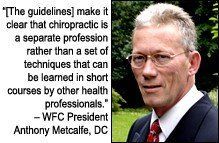Spearheaded by burgeoning scientific and clinical research literature, psychedelics have reached a level of media coverage and popular interest that has not been seen for over half a century. By “psychedelics,” we are referring to the unique class of substances that includes psilocybin (the active compound found in so-called “magic mushrooms”), LSD, dimethyltryptamine (DMT), ayahuasca, 5-MeO-DMT, and mescaline – each of which occurs in the natural world (except for LSD, which is a semi-synthetic compound).
WHO Releases Guidelines on Chiropractic Education
In early November, the World Health Organization (WHO) released Guidelines on Basic Training and Safety in Chiropractic, which provides recommendations to governments worldwide on chiropractic and minimum standards of education. The guidelines, developed in consultation with the World Federation of Chiropractic, the Association of Chiropractic Colleges, and various chiropractic, medical, osteopathic and other groups, recognize that the one full and acceptable level of education is that established by chiropractic accrediting agencies.

"The key significance of these new guidelines from WHO is that they make it clear that chiropractic is a separate profession, rather than a set of techniques that can be learned in short courses by other health professionals," commented Dr. Anthony Metcalfe, WFC president. "This is of great importance in the many countries where the practice of chiropractic is not yet regulated by law."

The guidelines recognize that in some countries and circumstances, there may need to be an interim program when chiropractic is first introduced, with slightly reduced hours for a short period. However, courses must still be close to the full level for reasons of competency and safety.
For example, at the interim level, a medical doctor or other professional wanting to requalify and offer chiropractic services should complete a course of at least 1,800 hours, with at least 1,000 of those hours being in supervised clinical training. He or she should offer those services as a qualified chiropractor, not as a medical doctor providing chiropractic services.
WFC Secretary-General David Chapman-Smith, who has led the negotiations with WHO on the guidelines during the past five years, offered several examples of why the guidelines are so important to the identity and future of the profession. First, in Argentina last year, MDs began a 12-month, part-time course in chiropractic of approximately 300 hours. Now, formally qualified DCs in Argentina can explain to their government why this course is inadequate, against the public interest, and should not continue or be recognized. Second, in Brazil, where a large physical therapy profession is concerned at the growth of the chiropractic profession in recent years: from three in 1990 to more than 100, now with over 600 students in two university programs - PTs are lobbying government to recognize chiropractic as a specialty of physical therapy. These new guidelines, from the strongest possible independent source, support the Brazilian Chiropractors' Association in answering that challenge.
Much credit for the guidelines also must go to Dr. John Sweaney, a former WFC president, who was selected by WHO as its consultant to prepare the first draft of the guidelines. The guidelines are currently in English only, but versions in French and Spanish are being prepared and will be available early next year.
For more information on the Guidelines on Basic Training and Safety in Chiropractic, including how to receive electronic or print copies, visit the WFC Web site (www.wfc.org) and go to the newsroom.



